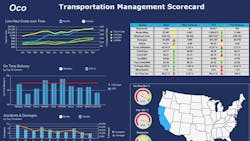Welch Foods Inc. spends more than $50 million annually to ship its juices, jams and jellies to customers throughout the world. The Concord, Mass.-based company, which is the processing and marketing arm of the National Grape Cooperative Association Inc., makes anywhere from 35,000 to 40,000 shipments each year to fulfill approximately 50,000 customer orders.
For Bill Coyne, Welch's director of purchasing and logistics, it's been a challenge to gain detailed, real-time insight into the cost structure of a vast logistics footprint that involves "a lot of moving parts" and "tons and tons of information."
That challenge was compounded in early 2008 when the company went live with a new Oracle ERP system that replaced the company's previous home-grown legacy system. In addition, Welch's used a separate freight-pay system to process its transportation-payment transactions.
With several different IT systems spread across the company in many different departments, Welch's lacked the visibility it needed to effectively analyze its transportation costs, explains William Copacino, president and CEO of Oco Inc., a Waltham, Mass.-based provider of software-as-a-service (SaaS)-based business intelligence (BI) systems.
In early 2008, Welch's implemented a SaaS-based BI system provided by Oco. The system includes a reporting tool that enables Welch's to view data from three disparate IT systems in a single Oco mini data warehouse.
The data warehouse gives Welch's the ability to report and produce key performance indicators (KPIs) within its dashboard, and Coyne notes that the tool gives Welch's the flexibility to "slice and dice data across the data warehouse" however the company sees fit. By virtue of the system's Google-like ease of use, as Coyne describes it, that data is accessible to employees at all levels of the company.
The added visibility paid immediate dividends, says Coyne, who estimates that the BI tool paid for itself in the first 30 days of being implemented. For example, by analyzing customer order patterns, Welch's identified opportunities to improve truck-capacity utilization.
"In the transportation world, you may pay $500 for a truck to move your product from Point A to Point B," Coyne says. "And if that truck can hold 42,000 pounds of Welch's product, and you're only putting 38,000 pounds on it, you're still paying the same price. So if you can analyze your order patterns and maximize what's going onto that truck, you're not only cutting your transportation costs, but you're being more environmentally friendly, because you're taking trucks off the highway."
On the flip side, Welch's was able to improve its day-of-the-week shipping capacity, which helps to secure lower shipping rates from transportation vendors.
"Using the Oco tool, we were able to analyze the number of orders and volume by day and look at the days that were overloaded versus days that were lightly loaded," Coyne explains. "Kind of surprisingly -- we have a pretty widely scattered operation -- we found that in many instances we were creating orders where we were managing our customers' inventories through continuous-replenishment processes and where we were managing orders to move between our plants and distribution centers. So moving those orders out of the heavy days was something that was easy to do, and it's really something we couldn't see in our old systems."
The BI tool allows Welch's to analyze its logistics costs, volume and order flow "by many different dimensions," including by geography, manufacturing plant, distribution center, carrier, customer and shipping form, according to Coyne. Welch's now can aggregate any time periods, compare year-over-year time periods and analyze volume and cost by any sales division.
"But the real beauty of this is that we have every data element on every order, every bill of lading and every freight bill in a single data warehouse, and with the ability to look at it in any way that we want, and then, beyond that, the ability to drill all the way down to an individual freight bill order or bill of lading," Coyne says. "If we see something that looks the least bit funny, we have the ability to drill down to an individual shipment or shipments."
In the "old world" (before BI), logistics had to ask IT to develop reports, "and it would take an extended amount of time for them to develop that report, and then they'd give it to you and you'd begin using it and maybe after the first week you would say, 'Geez, I wish I would've asked for this other bit of information,'" Coyne explains.
"Now we say, 'OK, let's just take all the information we could possibly want to look at, put it into a data warehouse and then we'll write the reports ourselves," Coyne says. "There's almost nothing that we want to know that we can't know within a minute or two."
Example of Oco's Transportation Scorecard
BI software from Oco gives Welch's the ability to analyze its logistics costs and performance "by many different dimensions," according to Bill Coyne, director of purchasing and logistics.
About the Author
Josh Cable
Former Senior Editor
Former Senior Editor Josh Cable covered innovation issues -- including trends and best practices in R&D, process improvement and product development. He also reported on the best practices of the most successful companies and executives in the world of transportation manufacturing, which encompasses the aerospace, automotive, rail and shipbuilding sectors.
Josh also led the IndustryWeek Manufacturing Hall of Fame, IW’s annual tribute to the most influential executives and thought leaders in U.S. manufacturing history.
Before joining IndustryWeek, Josh was the editor-in-chief of Penton Media’s Government Product News and Government Procurement. He also was an award-winning beat reporter for several small newspapers in Northeast Ohio.
Josh received his BFA in creative writing from Bowling Green University, and continued his professional development through course-work at Ohio University and Cuyahoga Community College.
A lifelong resident of the Buckeye State, Josh currently lives in the Tremont neighborhood of Cleveland. When the weather cooperates, you’ll find him riding his bike to work, exercising his green thumb in the backyard or playing ultimate Frisbee.
